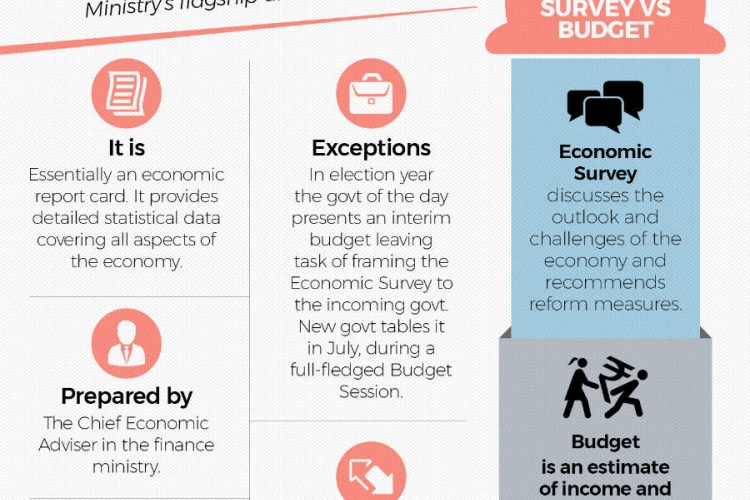Highlights of Economic Survey 2019-20
The Economic Survey projects the state of health of the Indian economy and outlines the challenges. The survey projected GDP growth at 7% for the financial year 2019-20. It was noted that the GDP growth has been seen picking up on higher private investment and robust consumption.
Highlights of the Survey:
- Global Oil prices set to decline in this financial year which mau boost consumption.
- To sustain a $5 Trillion economy, India need to maintain a growth rate of 8%
- The fiscal deficit estimate has been set at 3.4% of GDP
- Govt. policies are to lift more restrictions on FDI
- Lower global growth and increased uncertainty over trade tensions may hit exports
- Electric vehicle potential is enormous and India can emerge as a manufacturing hub for it
- The performance of the banking sector (domestic operations), Public Sector Banks (PSBs) in particular, improved in 2018- 19. The Gross Non-Performing Advances (GNPA) ratio of SCBs decreased from 11.5% to 10.1% between March 2018 and December 2018.
- However, NBFC have performed badly, says the Survey. “The GNPA ratio of NBFC sector deteriorated to 6.5% as in December 2018 from 6.1% in March 2018. The net NPA also increased marginally to 3.6% in December 2018 from 3.2% in March 2018.”
- NPAs in public sector banks down by 1.4 percentage points
- National TFR to be lower than replacement rate by 2021. The Survey predicts that the national Total Fertility Rate (TFR) will be lower than the replacement rate in 2021. The TFR for India as a whole is 2.3, currently. Rural areas have a TFR of 2.5, while urban areas are lower, at 1.8.
- The working age population is expected to grow by roughly 9.7million per year during 2021-31, and 4.2 million per year during 2031-41.
- The Survey expects a significant decline in elementary school-going children in the next two decades.
- Priority Sector Lending suggested for MSMEs
Firms with less than 100 workers account for more than 50% of all organised firms in manufacturing but contribute just 14% to employment and 14% to productivity. Larger firms account are only 15% by number, but account for 75% employment and close to 90% of productivity.
- The Survey suggests that MSMEs receive a 10-year sunset clause, that labour laws be deregulated and the sector be given priority in lending.
- This year’s Survey also focuses on sectors such as tourism, and other services.
Changes suggested in govt’s flagship scheme names
The Survey suggests that the government’s flagship schemes for social welfare and taxation be changed to more accurately reflect the Centre's agenda. The document suggests a behavioural economics approach to naming these schemes.The changes, as suggested, are:
- From ‘Beti Bachao Beti Padhao’ to ‘BADLAV’ (Beti Aapki Dhan Lakshmi Aur Vijay Lakshmi)
- From ‘Swachh Bharat’ to ‘Sundar Bharat’
- From ‘Give It Up” for LPG subsidy to ‘Think about the Subsidy’
- From ‘tax evasion’ to ‘tax compliance’
Steps for sustained growth
- Data as a public good, emphasising legal reforms, ensuring policy consistency, encouraging behavior change using behavioral economics, nourishing MSMEs, reducing the cost of capital, reducing risk-return trade-off for investments, are some of the focus of the Survey.
- The Survey “departs from traditional Anglo-Saxon thinking by viewing the economy as being either in a virtuous or a vicious cycle, and thus never in equilibrium”.
- predicted real Gross Domestic Product (GDP) growth rate at 7 per cent. The annual document also cautions against new schemes being funded at the cost of raising the fiscal gap.
- For new schemes to be funded, the Centre needs revenue and the economic survey says that revenue mop-up may be hit if growth slows in the current financial year.
- The survey also informed that falling nominal GDP growth shows secular inflation fall. The share of informal sector to manufacturing growth fell in the previous financial year, says the survey.
- Pointing at the possible hurdles for the economy in the future, the survey said slow growth, GST and farm schemes will pose challenges on the fiscal front.
- The already struggling export sector of India may further slump as lower global growth, increased uncertainty over trade tension may hit exports. However, an aggressive export strategy must be part of investment-driven model.


 IAS -2025 Prelims Combined Mains Batch - III Starts - 14-04-2024
IAS -2025 Prelims Combined Mains Batch - III Starts - 14-04-2024